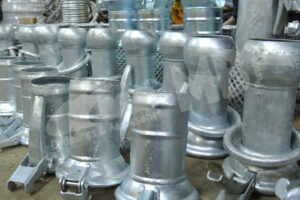One of the most typical temporary pump applications on construction sites is water removal. When building new residential or industrial areas, workers may come into contact with water while laying the foundation for the project or installing the infrastructure.
There are numerous configurations for the equipment in a pump application, but they always require two key components. Downtime for dewatering pumps can seriously compromise site safety and reduce everyone’s productivity. Unpredictable cost increases are associated with the second component. Manufacturers of high-performance pumps are more interested than ever in finding ways to reduce equipment downtime and increase productivity.
Know your dewatering pumps’ ideal working conditions.
MB Exports are one of the best Dewatering Pump Manufacturers & Suppliers in India. Dewatering pumps are frequently sized and chosen depending on particular application criteria such as the suction lift, static discharge head, necessary flow rates, and hose/pipe arrangement. This scaling requirement frequently becomes unnecessary since the actual scenario differs from the initial expectations.
A set of pressure gauges can serve as a guide for operators when they do not have access to the technical documentation and the dewatering pump is operating within its Recommended Operating Range (ROR). Operation outside of the ROR may result in inefficiencies, excessive wear, and malfunctions of the pump.
When the pump is primed but not operating, a vacuum gauge on the suction port of the pump displays the inlet pressure. It refers to the value of vertical suction lift. The gauge assists in calculating the real friction losses in the suction line when the pump is operating.
The discharge pressure gauge displays the pressure needed to overcome friction losses and the static discharge head that occurs when water moves through the pumping system. Total Dynamic Head (TDH) is the total of the suction lift, discharge head, and all friction losses. The duty point of the pump system is represented by TDH and the known flow rate.
A tip: To determine whether you are operating inside the prescribed operating range, read the vacuum and pressure gauge numbers as well as the dewatering pump speed to determine the duty point. It will reduce operational expenses and prevent breakdowns and downtime.
Quick restart of operations with powerful pumps
Dewatering a building site is difficult enough without having to worry about the pump clogging up. It indicates that large pieces reach the dewatering pump volute but do not depart, resulting in insufficient flow rates. When the appropriate suction strainer is not installed, these circumstances frequently happen. To solve the problem, an immediate response is essential.
The first step is to get rid of anything that is obstructing the flow of the pump system as a whole. If applicable, a pump’s swing door provides simple access to the wear parts so that impediments can be removed securely. Always keep in mind that installing a suction strainer is highly advised to prevent clogging.
The perfect suction strainer is robustly built, corrosion resistant, and has a total open area that is five times bigger than the suction line’s open area. Dewatering applications are always facilitated by high-performance pumps with clever design elements.
Reduce operating expenses, carbon footprint
The answer to the frequently posed question “How long can the pump run dry?” must first be divided down into a few illuminating subtopics. When a pump is operating without any liquid or the medium to be pumped, the state is known as “dry running.”
I advise keeping the pump’s internal liquid flowing. Liquid in motion assists in cooling down portions that are affected by friction and heat buildup. It also lubricates the mechanical seal, in addition.
The initial query should be changed to “Can we maintain a dry work area without running the pump dry?” A pump is said to be “dry running” when it’s not moving any liquid or media. Installing a level regulation system is a quick and easy technique to prevent dry running. According to the necessary level and behaviour, the so-called “auto-start mode” will run the pump.
Let’s examine a case in point. When a high flow centrifugal dry prime pump is run at 1600 rpm with a 74 horsepower diesel engine. The engine uses an average of 2.65 litres (0.7 gallons) of diesel fuel per hour when there is no load or pumping activity. Now assuming that the pump is only required to run for 9 out of 12 hours every shift. 7.9 litres (2.1 gallons) of diesel fuel can be saved each day. Additionally, a reduction of three daily running hours will add three weeks to the 500-hour engine servicing.
Operating the pump only when necessary will have many advantages, including daily fuel savings. An extended maintenance interval with associated direct cost savings, a smaller carbon footprint, and longer component lifespans.
Read more about the Dewatering Pump uses and its types
MB Exports are the Best Dewatering Pump Manufacturers in India. Learn how to reduce downtime with the upcoming dewatering solution to maximise cost savings. By being aware of the ideal operating circumstances and using pressure readings to diagnose the system, you may reduce downtime. Returning a machine to operation after a breakdown necessitates quick action and, preferably, intelligent product features.
By making sure that the equipment only uses itself when necessary, there are also further potential cost savings. Spending on fuel and maintenance has a direct beneficial effect. Additionally, it is possible to increase component longevity and decrease the need of fossil fuels.




